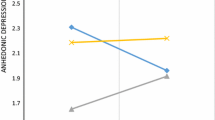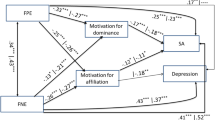Abstract
Although a substantial body of research has examined the relationship between motivational systems and mood and anxiety disorders, there is disagreement among theorists regarding the nature of these relationships. Discrepancies in the literature may be explained by several factors. Studies of motivational models rarely examine both mood and anxiety disorders simultaneously, making comparisons among them difficult. Furthermore, dimensions of anxiety often are not distinguished, obscuring potential relationships. Finally, although research in this area is beginning to conceptualize individual differences in motivational systems as longstanding temperament phenomena, this notion has not been widely incorporated into motivational models. The present study examined relationships between temperamental differences in approach and avoidance motivational systems and dimensions of anxiety and depression. Results revealed distinct relationships between motivational temperaments and each psychopathology dimension. Present findings implicate individual differences in temperamental motivation as a potential factor in the development and/or maintenance of mood and anxiety disorders.

Similar content being viewed by others
Notes
Some researchers have suggested additional dimensions important for emotional and motivational processes, such as constraint/impulsivity (Carver 2005).
References
Andrews, V. H., & Borkovec, T. D. (1988). The differential effects of inductions of worry, somatic anxiety, and depression on emotional experience. Journal of Behavior Therapy and Experimental Psychiatry, 19, 21–26.
Barlow, D. H. (1986). Anxiety and its disorders: The nature and treatment of anxiety and panic. New York, NY: Guilford Press.
Barlow, D. H. (1991). Disorders of emotion. Psychological Inquiry, 2, 58–71.
Beck, A. T. (1967). Depression. New York: Harper & Row.
Bentler, P. M. (1990). Comparative fit indexes in structural models. Psychological Bulletin, 107, 238–246.
Bollen, K. A. (1989). Structural equations with latent variables. New York: Wiley.
Bradley, M. M., Codispoti, M., Cuthbert, B. N., & Lang, P. J. (2001). Emotion and motivation I: Defensive and appetitive reactions in picture processing. Emotion, 1, 276–298.
Brown, T. A., Chorpita, B. F., & Barlow, D. H. (1998). Structural relationships among dimensions of the DSM-IV anxiety and mood disorders and dimensions of negative affect, positive affect, and autonomic arousal. Journal of Abnormal Psychology, 107, 179–192.
Buss, A. H., & Plomin, R. (1984). Temperament: Early developing personality traits. Hillsdale, NJ: Erlbaum.
Cacioppo, J. T., Gardner, W. L., & Berntson, G. G. (1999). The affect system has parallel and integrative processing components: Form follows function. Journal of Personality and Social Psychology, 76, 839–855.
Carver, C. S. (2005). Impulse and constraint: Perspectives from personality psychology, convergence with other areas, and potential for integration. Personality and Social Psychology Review, 9, 312–333.
Carver, C. S., Sutton, S. K., & Scheier, M. F. (2000). Action, emotion, and personality: Emerging conceptual integration. Personality and Social Psychology Bulletin, 26, 741–751.
Carver, C. S., & White, T. L. (1994). Behavioral inhibition, behavioral activation, and affective responses to impending reward and punishment: The BIS/BAS scales. Journal of Personality and Social Psychology, 67, 319–333.
Clark, L. A., & Watson, D. (1991). Tripartite model of anxiety and depression: Psychometric evidence and taxonomic implications. Journal of Abnormal Psychology, 100, 316–336.
Clark, L. A., Watson, D., & Mineka, S. (1994). Temperament, personality, and the mood and anxiety disorders. Journal of Abnormal Psychology, 103, 103–116.
Costa, P. T., & McCrae, R. R. (1992). Revised NEO personality inventory (NEOPI-R and Five Factor Inventory (NEO-FFI) professional manual. Odessa, FL: Psychological Assessment Resources.
Davidson, R. J. (1983). Hemispheric specialization for cognition and affect. In A. Gale & J. A. Edwards (Eds.), Physiological correlates of human behavior (pp. 203–216). London: Academic Press.
Davidson, R. J. (1998). Affective style and affective disorders: Perspectives from affective neuroscience. Cognition and Emotion, 12, 307–330.
Davidson, R. J. (2002). Anxiety and affective style: Role of prefrontal cortex and amygdala. Biological Psychiatry, 51, 68–80.
Dickson, J. M., & MacLeod, A. K. (2004). Anxiety, depression, and approach and avoidance goals. Cognition and Emotion, 18, 423–430.
Elliot, A. J., & Covington, M. V. (2001). Approach and avoidance motivation. Educational Psychology Review, 13, 73–92.
Elliot, A. J., & Thrash, T. M. (2002). Approach-avoidance motivation in personality: Approach and avoidance temperaments and goals. Journal of Personality and Social Psychology, 82, 804–818.
Engels, A. S., Heller, W., Mohanty, A., Herrington, J. D., Banich, M. T., Webb, A. G., et al. (2007). Specificity of regional brain activity in anxiety types during emotion processing. Psychophysiology, 44, 352–363.
Engels, A. S., Heller, W., Spielberg, J. M., Warren, S. L., Sutton, B. P., Banich, M. T., et al. (2010). Anxiety comorbidty influences patterns of brain asymmetry in depression. Cognitive, Affective, & Behavioral Neuroscience, 10, 141–156.
Gable, S. L., Reis, H. T., & Elliot, A. J. (2003). Evidence for bivariate systems: An empirical test of appetition and aversion across domains. Journal of Research in Personality, 37, 349–372.
Gray, J. A. (1981). A critique of Eysenck’s theory of personality. In H. J. Eysenck (Ed.), A model for personality (pp. 246–276). Berlin: Springer.
Gray, J. A. (1990). Brain systems that mediate both emotion and cognition. Cognition and Emotion, 4, 269–288.
Gray, J. A. (1994). Three fundamental emotion systems. In P. Ekman & R. J. Davidson (Eds.), The nature of emotion: Fundamental questions (pp. 243–247). New York: Oxford University Press.
Heller, W., & Nitschke, J. B. (1998). The puzzle of regional brain activity in depression and anxiety: The importance of subtypes and comorbidity. Cognition and Emotion, 12, 421–447.
Heller, W., Nitschke, J. B., Etienne, M. A., & Miller, G. A. (1997). Patterns of regional brain activity differentiate types of anxiety. Journal of Abnormal Psychology, 106, 376–385.
Henriques, J. B., & Davidson, R. J. (2000). Decreased responsiveness to reward in depression. Cognition and Emotion, 14, 711–724.
Higgins, E. T. (1997). Beyond pleasure and pain. American Psychologist, 52, 1280–1300.
Higgins, E. T. (2001). Promotion and prevention experiences: Relating emotions to nonemotional motivational states. In J. P. Forgas (Ed.), Handbook of affect and social cognition (pp. 186–211). Mahwah, NJ: Lauwrence Erlbaum Associates.
Hu, L., & Bentler, P. M. (1999). Cutoff criteria for fit indexes in covariance structure analysis: Conventional criteria versus new alternatives. Structural Equation Modeling, 6, 1–55.
Idson, L. C., Liberman, N., & Higgins, E. T. (2000). Distinguishing gains from nonlosses and losses from nongains: A regulatory focus perspective on hedonic intensity. Journal of Experimental Social Psychology, 36, 252–274.
Judd, L. L., Schettler, P. J., & Akiskal, H. S. (2002). The prevelance, clinical relevance, and public health significance of subthreshold depressives. The Psychiatric Clinics of North Americas, 25, 685–698.
Kessler, R. C., McGonagle, K. A., Zhao, S., Nelson, C. B., Hughes, M., Eshleman, S., et al. (1994). Lifetime and 12-month prevalence of DSM-III-R psychiatric disorders in the United States. Results from the National Comorbidity Survey. Archives of General Psychiatry, 51, 8–19.
Lang, P. J., Bradley, M. M., & Cuthbert, B. N. (1998). Emotion, motivation, and anxiety: Brain mechanisms and psychophysiology. Biological Psychiatry, 44, 1248–1263.
Layne, C. (1980). Motivational deficit in depression: People’s expectations x outcomes’ impacts. Journal of Clinical Psychology, 36, 647–652.
Layne, C., Lefton, W., Walters, D., & Merry, J. (1983). Depression: Motivational deficit versus social manipulation. Cognitive Therapy and Research, 7, 125–132.
Layne, C., Merry, J., Christian, J., & Ginn, P. (1982). Motivational deficit in depression. Cognitive Therapy and Research, 6, 259–273.
Lewin, K. (1935). A dynamic theory of personality. New York: McGraw-Hill.
Martell, C. R., Addis, M. E., & Jacobson, N. S. (2001). Depression in context: Strategies for guided action. New York: Norton.
Meehl, P. E. (1975). Hedonic capacity: Some conjectures. Bulletin of the Menninger Clinic, 39, 295–307.
Meyer, T. J., Miller, M. L., Metzger, R. L., & Borkovec, T. D. (1990). Development and validation of the Penn State Worry Questionnaire. Behavior Research and Therapy, 28, 487–495.
Mineka, S., Watson, D., & Clark, L. A. (1998). Comorbidity of anxiety and unipolar mood disorders. Annual Review of Psychology, 49, 377–412.
Molina, S., & Borkovec, T. D. (1994). The Penn State Worry Questionnaire: Psychometric properties and associated characteristics. In G. C. L. Davey & F. Tallis (Eds.), Worrying: Perspectives on theory, assessment, and treatment (pp. 265–283). Chichester: Wiley.
Nitschke, J. B., Heller, W., Imig, J. C., McDonald, R. P., & Miller, G. A. (2001). Distinguishing dimensions of anxiety and depression. Cognitive Therapy and Research, 25, 1–22.
Nitschke, J. B., Heller, W., Palmieri, P. A., & Miller, G. A. (1999). Contrasting patterns of brain activity in anxious apprehension and anxious arousal. Psychophysiology, 36, 628–637.
Preisig, M., Merikangas, K. R., & Angst, J. (2001). Clinical significance and comorbidity of subthreshold depression and anxiety in the community. Acta Psychiatrica Scandinavica, 104, 96–103.
Rottenberg, J. (2008). Mood and emotion in major depression. Current Directions in Psychological Science, 14, 167–170.
Shankman, S. A., Klein, D. N., Tenke, C. E., & Bruder, G. E. (2007). Reward sensitivity in depression: A biobehavioral study. Journal of Abnormal Psychology, 116, 95–104.
Spielberg, J. M., De Leon, A. A., Heller, W., Bredemeier, K., Engels, A. S., Warren, S. L. (2010). Habituation to negative stimuli distinguishes types of anxiety (submitted).
Steiger, J. H., & Lind, J. C. (1980). Statistically based tests for the number of factors. Iowa City, IA: Paper presented at the annual spring meeting of the Psychometric Society.
Tomarken, A. J., & Keener, A. D. (1998). Frontal brain asymmetry and depression: A self-regulatory perspective. Cognition and Emotion, 12, 387–420.
Tucker, L. R., & Lewis, C. (1973). A reliability coefficient for maximum likelihood factor analysis. Psychometrika, 38, 1–10.
Watson, D., & Clark, L. A. (1993). Behavioral disinhibition versus constraint: A dispositional perspective. In D. M. Wegner & J. W. Pennebaker (Eds.), Handbook of mental control (pp. 506–527). New York, NY: Prentice Hall.
Watson, D., Clark, L. A., Weber, K., Assenheimer, J. S., Strauss, M. E., & McCormick, R. A. (1995a). Testing a tripartite model: II. Exploring the symptom structure of anxiety and depression in student, adult, and patient samples. Journal of Abnormal Psychology, 104, 15–25.
Watson, D., Weber, K., Assenheimer, J. S., Clark, L. A., Strauss, M. E., & McCormick, R. A. (1995b). Testing a tripartite model: I. Evaluating the convergent and discriminant validity of anxiety and depression symptom scales. Journal of Abnormal Psychology, 104, 3–14.
Author information
Authors and Affiliations
Corresponding author
Rights and permissions
About this article
Cite this article
Spielberg, J.M., Heller, W., Silton, R.L. et al. Approach and Avoidance Profiles Distinguish Dimensions of Anxiety and Depression. Cogn Ther Res 35, 359–371 (2011). https://doi.org/10.1007/s10608-011-9364-0
Published:
Issue Date:
DOI: https://doi.org/10.1007/s10608-011-9364-0




